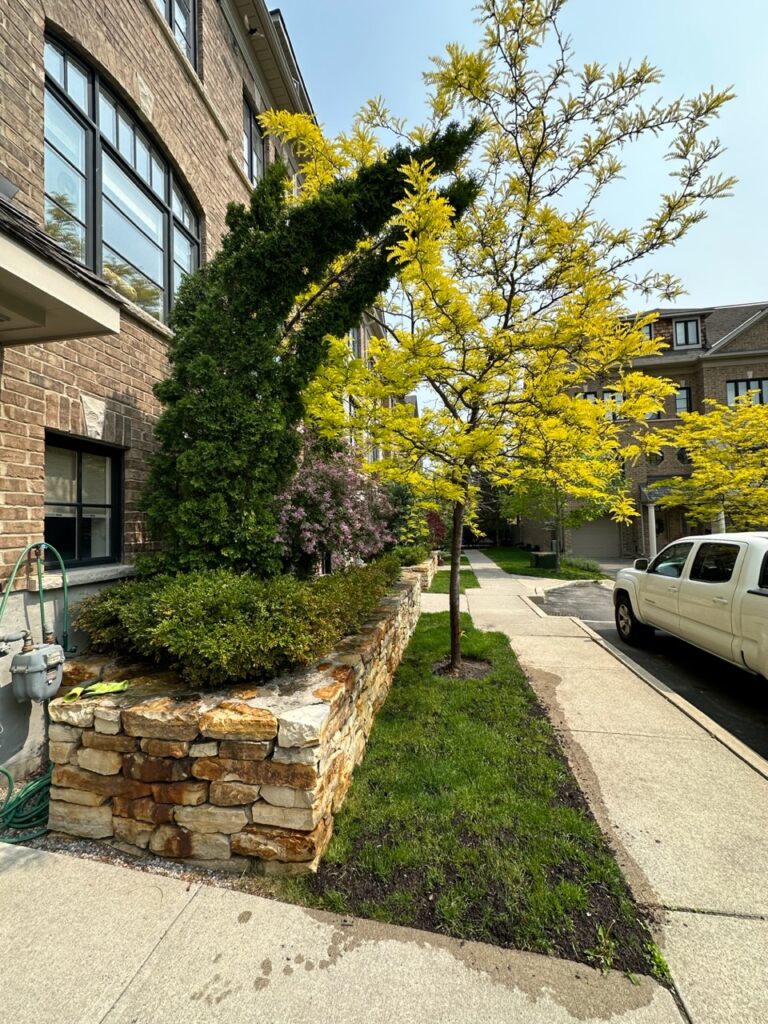
The trunk is bent half way. Still looks green. Is it ok to cut the trunk where it starts to bend?
It’s about 13 years old and about 15feet tall.
Please advise any other tips.
I’ll assume that your tree is an American arborvitae (Thuja occidentalis, also called Eastern or Northern white cedar). As there are 5 species of Arborvitae (Thuja), you may want to verify that this is accurate.
It’s not clear why your tree is leaning/bent. It could be because of strong winds or incorrect planting, among other reasons. Consider whether it has been bent for several years, or if this started recently (heavy wet snow from the roof, for example). If it’s been on a tilt for years, this is likely not easily corrected. In any event, it is important to determine why the tree is leaning – to avoid the problem arising again.
As your tree is well-established, I suggest that you speak to an arborist to make the best choice for your tree. Landscape Ontario provides names and contact information for these professionals, you should be able to find a knowledgeable one in your area. To correct the tilt, there might be a few options – you can discuss these (and possibly others) with the expert:
- If the issue is a leader branch that is leaning, attach the tree using a cotton rope to a solid support, e.g., one or more stakes. Keep it staked for the next year or so and see if it starts to grow straighter. Your tree is 13 years old, and being so well-established, roping may not be the best solution.
- If the tree had been planted incorrectly, staking and repositioning the rootball may be an option, but involve a lot of work and significant expertise. Stakes must be firmly anchored and should be at least 2/3 the height of the tree, and you would need to dig around the trunk in a circle that is 25 cm (10 inches) wide per inch of trunk diameter in order to get under the root system (at least 60 cm (2 feet)) and free the roots. Next, pull the trunk upright using a rope wrapped over a sturdy piece of padding that has been wrapped around the trunk.
- From the photo you provide, it looks like you want to remove about the top 2/3 of the tree – the “bend” seems to start from quite a low spot in the tree, and possibly from 2 or more leaders. Generally it’s not recommended to cut back over 20% of the height of the Arborvitae. And in cutting the tree back, you would want to preserve its (desired) triangular shape, so that the base is wider than the top and all branches will still get good sun exposure. “Topping” a tree is usually done when the tree gets too high, not to correct a tilt. Note that if you cut the top off the tree, the resultant tree would look very flat at the top, and its lovely form won’t return. Once the central leader or branch tips that grow upwards have been cut, there will be no new growth. However, cutting or pruning stimulates new growth and should be done in late spring (around now, it’s end-May) or early summer. If done later in the season, the new growth would be vulnerable to cold temperatures as we head into fall.
All the best in keeping your lovely tree healthy, upright and looking terrific!

